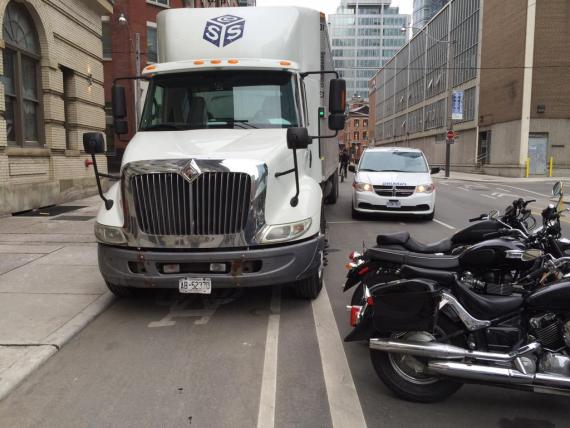Councillor Kristyn Wong-Tam is calling for a "review" of the recently installed—and extensively consulted—cycle tracks of Wards 27 and 28. She is asking Transportation Services to investigate two contradictory concerns: "the improper parking of delivery and passenger vehicles in bike lanes; and access concerns raised by persons with medical issues, disabilities and the elderly who can no longer directly access their homes or medical services and facilities". (Photo by Ian Flett)
I'm suspicious of Councillor Wong-Tam's intentions given her previous interactions with cycling infrastructure. So what'll it be? Shall we make holes in the cycle tracks for legitimate concern X? And how shall we prevent everyone else from also stopping there?
It's telling that Wong-Tam is the only signatory on this letter. A constituent has told me that office of Ward 28 Councillor Pam McConnell provided feedback on the letter but for some unknown (to us) reason, she didn't sign it. This is interesting given that at least half of the cycle tracks are in McConnell's ward.
This isn't the first time Wong-Tam has written Transportation staff asking them to review cycle tracks. She wrote staff asking them to make the Sherbourne cycle tracks a "pilot" rather than permanent. McConnell didn't sign the letter that time either.
The timing of the letter is odd. Her letter is dated February, 2015 and requested a report back from staff for May. But she won't get a report for September of this year, which will likely be after the road work is completed on the lower half of Sherbourne. Too late to make any changes there.
The community, including the disabled, was extensively consulted prior to the installation. I recall staff telling me how they went building by building alerting residents, businesses and requested their feedback. They met extensively with BIAs and RAs. So why now?
Coincidence?
I heard something interesting from a city planner soon after I was alerted to Wong-Tam's letter. I don't have any proof that this is related to her letter but it might be a clue.
The planner mentioned that 24 Wellesley, a condo tower, has requested curb cuts into the cycle track curbs so that their residents can be dropped off at the front door. Planner said they wanted it for Wheel-Trans, but really, there's no way of stopping anyone from using it.
The funny thing is is that 24 Wellesley has minor streets on all three sides with plenty of places to stop! So it seems a bit greedy that they also want holes in the cycle track as well. And you'll notice that there are a number of businesses also in that building that presumably aren't happy with losing the stopping space in front of their stores.

And this isn't the only condo tower. Apparently there are others who also want to poke holes into the cycle track. Is Wong-Tam helping to push these requests?
Here's what Wong-Tam wants reviewed:
- Locations of frequent parking in bike lanes and separation conditions (bollards and their spacing or curb type)
- Locations where Wheel-Trans and accessibility taxis cannot serve persons living with disabilities and where the City may not be meeting the requirements of the Accessibility for Ontarians with Disabilities Act
- Locations where parking obstructions force cyclists to merge unsafely with automotive traffic
- Locations where residents feel they are forced to park or be dropped off that are unsafe, due to traffic conditions or poor visibility
- Solutions and recommendations to remedy the conflicts to ensure safer street conditions for all bike lane and road users.
I hope Wong-Tam realizes that nothing is ever going to satisfy everyone. Her concerns contradict each other: if she identifies a problem with car drivers parking in the bike lanes, that is, there isn't enough physical separation, then why also call for a solution to residents and Wheel-Trans? If we increase the physical separation (which is what most cyclists want) then it's going to inevitably put some noses out of joint. That can't be fixed. And if they instead allow for gaps in the separation, we can't pretend that only Wheel-Trans or residents will use them. That gap is available to everyone.
So before we know it, the entire cycle track will be riddled with gaps where people can stop to pick up their coffee or wait with their engines idling because "it'll just be a minute". A route that is so easily blocked is no longer a safe or effective cycling route.
In whose interests is Councillor Wong-Tam fighting for? She also fought for off-hours on-street parking on Yonge and Bay, which increases the chances of injuries due to dooring for cyclists (and cancels out the benefit of bike lanes!) and makes public transit less efficient (by removing the priority lane for buses).
It makes me wary that Wong-Tam really has the best interests of cyclists at heart. If nothing else, we need to hear from her that she actually does support physically separated bike lanes. And that she will push for improvements to accessibility for the disabled that won't create gaps in the cycle tracks that will be used to make cycling more dangerous. That's the least she could do.

